
A | B | C | D | E | F | G | H | CH | I | J | K | L | M | N | O | P | Q | R | S | T | U | V | W | X | Y | Z | 0 | 1 | 2 | 3 | 4 | 5 | 6 | 7 | 8 | 9
| Part of a series on |
| Buddhism |
|---|
 |
Buddhism (/ˈbʊdɪzəm/ BUUD-ih-zəm, US also /ˈbuːd-/ BOOD-),[1][2][3] also known as Buddha Dharma and Dharmavinaya, is an Indian religion[a] and philosophical tradition based on teachings attributed to the Buddha.[7] It is the world's fourth-largest religion,[8][9] with over 520 million followers, known as Buddhists, who comprise seven percent of the global population.[10][11] Buddhism originated in the eastern Gangetic plain as a śramaṇa–movement in the 5th century BCE, and gradually spread throughout much of Asia via the Silk Road.
According to Buddhist tradition, the Buddha taught that attachment or clinging causes dukkha (often translated as "suffering" or "unease"[note 1]), but that there is a path of development which leads to awakening and full liberation from dukkha.[16] This path involves elements such as meditation and ethical precepts rooted in non-harming, with the Buddha regarding his teachings as a Middle Way between extremes such as asceticism or hedonism.[17][18] Other widely observed elements include: the doctrines of dependent origination, the three marks of existence, and karma; monasticism; the Three Jewels; and the cultivation of perfections (pāramitā).[19]
Buddhist schools vary in their interpretation of the paths to liberation (mārga) as well as the relative importance and "canonicity" assigned to various Buddhist texts, and their specific teachings and practices.[20][21] Two major extant branches of Buddhism are generally recognized by scholars: Theravāda (lit. 'School of the Elders') and Mahāyāna (lit. 'Great Vehicle'). The Theravada tradition emphasizes the attainment of nirvāṇa (lit. 'extinguishing') as a means of transcending the individual self and ending the cycle of death and rebirth (saṃsāra),[22][23][24] while the Mahayana tradition emphasizes the Bodhisattva ideal, in which one works for the liberation of all sentient beings. Additionally, Vajrayāna (lit. 'Indestructible Vehicle'), a body of teachings incorporating esoteric tantric techniques, may be viewed as a separate branch or tradition within Mahāyāna.[25]
The Buddhist canon is vast, with many different textual collections in different languages (such as Sanskrit, Pali, Tibetan, and Chinese).[26] The Theravāda branch has a widespread following in Sri Lanka as well as in Southeast Asia, namely Myanmar, Thailand, Laos, and Cambodia. The Mahāyāna branch—which includes the traditions of Zen, Pure Land, Nichiren, Tiantai, Tendai, and Shingon—is predominantly practised in Nepal, Bhutan, China, Malaysia, Vietnam, Taiwan, Korea, and Japan. Tibetan Buddhism, which preserves the Vajrayāna teachings of eighth-century India, is practised in the Himalayan states as well as in Mongolia[27] and Russian Kalmykia.[28] Historically, until the early 2nd millennium, Buddhism was widely practiced in the Indian subcontinent;[29][30][31] it also had a foothold to some extent elsewhere in Asia, namely Afghanistan, Turkmenistan, Uzbekistan, and Tajikistan.[32]
Etymology
The names Buddha Dharma and Bauddha Dharma come from Sanskrit: बुद्ध धर्म and बौद्ध धर्म respectively ("doctrine of the Enlightened One" and "doctrine of Buddhists"). Dharmavinaya comes from Sanskrit: धर्मविनय, literally meaning "doctrines disciplines".
The Buddha ("the Awakened One") was a Śramaṇa who lived in South Asia c. 6th or 5th century BCE.[33][34] Followers of Buddhism, called Buddhists in English, referred to themselves as Sakyan-s or Sakyabhiksu in ancient India.[35][36] Buddhist scholar Donald S. Lopez asserts they also used the term Bauddha,[37] although scholar Richard Cohen asserts that that term was used only by outsiders to describe Buddhists.[38]
The Buddha




Details of the Buddha's life are mentioned in many Early Buddhist Texts but are inconsistent. His social background and life details are difficult to prove, and the precise dates are uncertain, although the 5th century BCE seems to be the best estimate.[39][note 2]
Early texts have the Buddha's family name as "Gautama" (Pali: Gotama), while some texts give Siddhartha as his surname. He was born in Lumbini, present-day Nepal and grew up in Kapilavastu,[note 3] a town in the Ganges Plain, near the modern Nepal–India border, and he spent his life in what is now modern Bihar[note 4] and Uttar Pradesh.[47][39] Some hagiographic legends state that his father was a king named Suddhodana, his mother was Queen Maya.[48] Scholars such as Richard Gombrich consider this a dubious claim because a combination of evidence suggests he was born in the Shakya community, which was governed by a small oligarchy or republic-like council where there were no ranks but where seniority mattered instead.[49] Some of the stories about the Buddha, his life, his teachings, and claims about the society he grew up in may have been invented and interpolated at a later time into the Buddhist texts.[50][51]
Various details about the Buddha'a background are contested in modern scholarship. For example, Buddhist texts assert that Buddha described himself as a kshatriya (warrior class), but Gombrich writes that little is known about his father and there is no proof that his father even knew the term kshatriya.[52] (Mahavira, whose teachings helped establish the ancient religion Jainism, is also claimed to be ksatriya by his early followers.[53])
According to early texts such as the Pali Ariyapariyesanā-sutta ("The discourse on the noble quest", MN 26) and its Chinese parallel at MĀ 204, Gautama was moved by the suffering (dukkha) of life and death, and its endless repetition due to rebirth.[54] He thus set out on a quest to find liberation from suffering (also known as "nirvana").[55] Early texts and biographies state that Gautama first studied under two teachers of meditation, namely Āḷāra Kālāma (Sanskrit: Arada Kalama) and Uddaka Ramaputta (Sanskrit: Udraka Ramaputra), learning meditation and philosophy, particularly the meditative attainment of "the sphere of nothingness" from the former, and "the sphere of neither perception nor non-perception" from the latter.[56][57][note 5]
Finding these teachings to be insufficient to attain his goal, he turned to the practice of severe asceticism, which included a strict fasting regime and various forms of breath control.[60] This too fell short of attaining his goal, and then he turned to the meditative practice of dhyana. He famously sat in meditation under a Ficus religiosa tree — now called the Bodhi Tree — in the town of Bodh Gaya and attained "Awakening" (Bodhi).[61][according to whom?]
According to various early texts like the Mahāsaccaka-sutta, and the Samaññaphala Sutta, on awakening, the Buddha gained insight into the workings of karma and his former lives, as well as achieving the ending of the mental defilements (asavas), the ending of suffering, and the end of rebirth in saṃsāra.[60] This event also brought certainty about the Middle Way as the right path of spiritual practice to end suffering.[17][18] As a fully enlightened Buddha, he attracted followers and founded a Sangha (monastic order).[62] He spent the rest of his life teaching the Dharma he had discovered, and then died, achieving "final nirvana", at the age of 80 in Kushinagar, India.[63][42][according to whom?]
The Buddha's teachings were propagated by his followers, which in the last centuries of the 1st millennium BCE became various Buddhist schools of thought, each with its own basket of texts containing different interpretations and authentic teachings of the Buddha;[64][65][66] these over time evolved into many traditions of which the more well known and widespread in the modern era are Theravada, Mahayana and Vajrayana Buddhism.[67][68]
Worldview
The term "Buddhism" is an occidental neologism, commonly (and "rather roughly" according to Donald S. Lopez Jr.) used as a translation for the Dharma of the Buddha, fójiào in Chinese, bukkyō in Japanese, nang pa sangs rgyas pa'i chos in Tibetan, buddhadharma in Sanskrit, buddhaśāsana in Pali.[69]
Four Noble Truths

The Four Noble Truths, or the truths of the Noble Ones,[70] taught in Buddhism are:
- Dukkha ("not being at ease", "suffering") is an innate characteristic of the perpetual cycle (samsara, lit. 'wandering') of grasping at things, ideas and habits
- Samudaya (origin, arising, combination; "cause"): dukkha is caused by taṇhā ("craving", "desire" or "attachment", literally "thirst")
- Nirodha (cessation, ending, confinement): dukkha can be ended or contained by the confinement or letting go of taṇhā
- Marga (path): the path leading to the confinement of taṇhā and dukkha, classically the Noble Eightfold Path but sometimes other paths to liberation
Three marks of existence
Most schools of Buddhism teach three marks of existence:[71]
- Dukkha: unease, suffering
- Anicca: impermanence
- Anattā: non-self; living things have no permanent soul or essence[72][73][74]
Buddhism teaches that the idea that anything is permanent or that there is self in any being is ignorance or misperception (avijjā), and that this is the primary source of clinging and dukkha.[75][76][77]
Some schools describe four characteristics or "four seals of the Dharma", adding to the above:
The cycle of rebirth

Saṃsāra
Saṃsāra means "wandering" or "world", with the connotation of cyclic, circuitous change.[80][81] It refers to the theory of rebirth and "cyclicality of all life, matter, existence", a fundamental assumption of Buddhism, as with all major Indian religions.[81][82] Samsara in Buddhism is considered to be dukkha, unsatisfactory and painful,[83] perpetuated by desire and avidya (ignorance), and the resulting karma.[81][84][85] Liberation from this cycle of existence, nirvana, has been the foundation and the most important historical justification of Buddhism.[86][87]
Zdroj:https://en.wikipedia.org?pojem=Buddhist
Text je dostupný za podmienok Creative Commons Attribution/Share-Alike License 3.0 Unported; prípadne za ďalších podmienok. Podrobnejšie informácie nájdete na stránke Podmienky použitia.
Antropológia
Aplikované vedy
Bibliometria
Dejiny vedy
Encyklopédie
Filozofia vedy
Forenzné vedy
Humanitné vedy
Knižničná veda
Kryogenika
Kryptológia
Kulturológia
Literárna veda
Medzidisciplinárne oblasti
Metódy kvantitatívnej analýzy
Metavedy
Metodika
Text je dostupný za podmienok Creative
Commons Attribution/Share-Alike License 3.0 Unported; prípadne za ďalších
podmienok.
Podrobnejšie informácie nájdete na stránke Podmienky
použitia.
www.astronomia.sk | www.biologia.sk | www.botanika.sk | www.dejiny.sk | www.economy.sk | www.elektrotechnika.sk | www.estetika.sk | www.farmakologia.sk | www.filozofia.sk | Fyzika | www.futurologia.sk | www.genetika.sk | www.chemia.sk | www.lingvistika.sk | www.politologia.sk | www.psychologia.sk | www.sexuologia.sk | www.sociologia.sk | www.veda.sk I www.zoologia.sk
